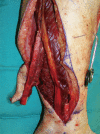Mandibular Reconstruction Using the Free Vascularized Fibula Graft: An Overview of Different Modifications
- PMID: 26848439
- PMCID: PMC4738125
- DOI: 10.5999/aps.2016.43.1.3
Mandibular Reconstruction Using the Free Vascularized Fibula Graft: An Overview of Different Modifications
Abstract
The reconstruction of the mandible is a complex procedure because various cosmetic as well as functional challenges must be addressed, including mastication and oral competence. Many surgical techniques have been described to address these challenges, including non-vascularized bone grafts, vascularized bone grafts, and approaches related to tissue engineering. This review summarizes different modifications of the free vascularized fibula graft, which, since its introduction by Hidalgo in 1989, has become the first option for mandibular reconstruction. The fibula free flap can undergo various modifications according to the individual requirements of a particular reconstruction. Osteocutaneous flaps can be harvested for reconstruction of composite defects. 'Double-barreling' of the fibula can, for instance, enable enhanced aesthetic and functional results, as well as immediate one-stage osseointegrated dental implantation. Recently described preoperative virtual surgery planning to facilitate neomandible remodeling could guarantee good results. To conclude, the free fibula bone graft can currently be regarded as the "gold standard" for mandibular reconstruction in case of composite (inside and outside) oral cavity defects as well as a way of enabling the performance of one-stage dental implantation.
Keywords: Fibula; Mandibular reconstruction; Microsurgery.
Conflict of interest statement
No potential conflict of interest relevant to this article was reported.
Figures




Similar articles
-
[Free-flap fibula for the reconstruction of composite mandibular defects].Acta Otorhinolaryngol Ital. 1996 Feb;16(1):25-9. Acta Otorhinolaryngol Ital. 1996. PMID: 8984836 Italian.
-
Vascularized Combined with Nonvascularized Fibula Flap for Mandibular Reconstruction: Preliminary Results of a Novel Technique.J Craniofac Surg. 2019 Jun;30(4):e365-e369. doi: 10.1097/SCS.0000000000005379. J Craniofac Surg. 2019. PMID: 30865125
-
Evaluation of Clinical Outcomes of Osseointegrated Dental Implantation of Fibula Free Flaps for Mandibular Reconstruction.JAMA Facial Plast Surg. 2016 May 1;18(3):201-6. doi: 10.1001/jamafacial.2015.2271. JAMA Facial Plast Surg. 2016. PMID: 26868226
-
Approach for Mandibular Reconstruction Using Vascularized Free Fibula Flap: A Review of the Literature.Cureus. 2022 Oct 11;14(10):e30161. doi: 10.7759/cureus.30161. eCollection 2022 Oct. Cureus. 2022. PMID: 36397914 Free PMC article. Review.
-
Conceptual considerations in mandibular reconstruction.Clin Plast Surg. 1995 Jan;22(1):61-9. Clin Plast Surg. 1995. PMID: 7743710 Review.
Cited by
-
Squamous Carcinoma of the Oral Cavity in Patient with Fanconi Anemia: A Challenging Reconstruction with Double-barrel Free Fibula Flap Case Report.Plast Reconstr Surg Glob Open. 2023 Nov 20;11(11):e5414. doi: 10.1097/GOX.0000000000005414. eCollection 2023 Nov. Plast Reconstr Surg Glob Open. 2023. PMID: 38025634 Free PMC article.
-
Thirty-eight-year follow-up of the first patient of mandibular reconstruction with free vascularized fibula flap.Head Face Med. 2021 Oct 28;17(1):46. doi: 10.1186/s13005-021-00293-z. Head Face Med. 2021. PMID: 34711252 Free PMC article.
-
Balsa wood for precise intra-operative bone contouring in fibula free-flap mandible reconstruction.Eur Arch Otorhinolaryngol. 2019 Aug;276(8):2339-2343. doi: 10.1007/s00405-019-05496-4. Epub 2019 Jun 19. Eur Arch Otorhinolaryngol. 2019. PMID: 31218448
-
A hierarchical vascularized engineered bone inspired by intramembranous ossification for mandibular regeneration.Int J Oral Sci. 2022 Jun 22;14(1):31. doi: 10.1038/s41368-022-00179-z. Int J Oral Sci. 2022. PMID: 35732648 Free PMC article.
-
Fentanyl versus Dexmedetomidine Infusion in Head and Neck Free Flap Surgery for Comparison of Hemodynamic Parameters and Anaesthetic Requirements: A Randomised Controlled Trial.Indian J Otolaryngol Head Neck Surg. 2024 Oct;76(5):4528-4536. doi: 10.1007/s12070-024-04905-3. Epub 2024 Jul 22. Indian J Otolaryngol Head Neck Surg. 2024. PMID: 39376373
References
-
- Erdmann D, Giessler GA, Bergquist GE, et al. Free fibula transfer: analysis of 76 consecutive microsurgical procedures and review of the literature. Chirurg. 2004;75:799–809. - PubMed
-
- Wallace CG, Chang YM, Tsai CY, et al. Harnessing the potential of the free fibula osteoseptocutaneous flap in mandible reconstruction. Plast Reconstr Surg. 2010;125:305–314. - PubMed
-
- Foster RD, Anthony JP, Sharma A, et al. Vascularized bone flaps versus nonvascularized bone grafts for mandibular reconstruction: an outcome analysis of primary bony union and endosseous implant success. Head Neck. 1999;21:66–71. - PubMed
-
- Pogrel MA, Podlesh S, Anthony JP, et al. A comparison of vascularized and nonvascularized bone grafts for reconstruction of mandibular continuity defects. J Oral Maxillofac Surg. 1997;55:1200–1206. - PubMed
Publication types
LinkOut - more resources
Full Text Sources
Other Literature Sources

